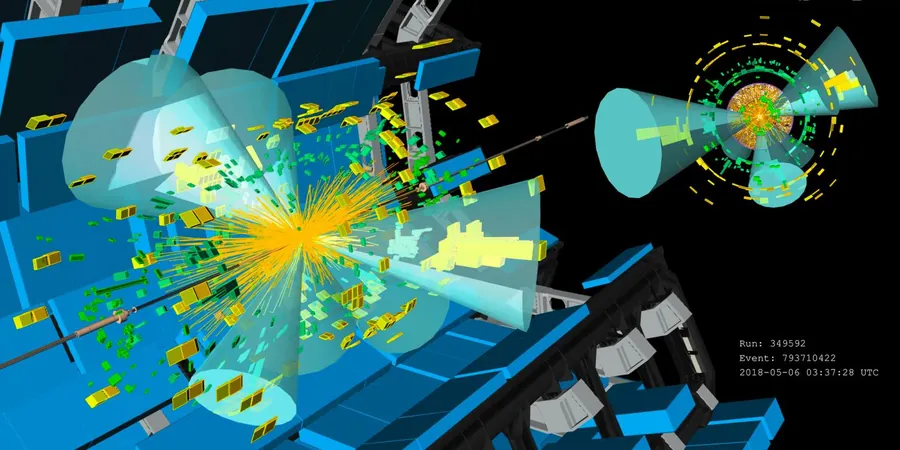
SpiralWave's Revolutionary Technology Turns Carbon Dioxide into Valuable Liquid Fuel
2024-10-28
Author: Arjun
Introduction
In an era where climate change poses an existential threat, innovative solutions often feel like something out of science fiction. SpiralWave is at the forefront of this movement, showcasing a groundbreaking method to tackle carbon emissions using advanced plasma technology. Co-founder and CEO Abed Bukhari revealed this extraordinary process during a captivating video demonstration, showcasing columns of vibrant, purple-tinted plasma that appeared to dance rhythmically within a metal enclosure.
Transforming CO2 into Liquid Fuel
This impressive technology is not just an aesthetic marvel; it serves a critical purpose: transforming carbon dioxide (CO2) from either the atmosphere or industrial emissions into usable liquid fuel. "You can observe the plasma emitting quick pulses, each responsible for breaking down CO2," Bukhari explained. This sophisticated mechanism employs three distinct microwave pulses, each set to a specific frequency designed to target and disrupt different molecular bonds, triggering multiple chemical reactions.
The first pulse disassociates CO2 molecules into carbon monoxide (CO), while the second pulse splits water (H2O) into hydrogen (H) and hydroxyl radicals (OH). Finally, the third pulse synthesizes these components into methanol, a versatile hydrocarbon that can be utilized in various applications.
Advantages of Methanol
Methanol's simplicity as a chemical compound is one of its major advantages, allowing it to be burned directly in internal combustion engines – something already employed in certain racing vehicles. Moreover, methanol can serve as a feedstock for producing more complex hydrocarbons, including jet fuel, while also providing crucial chemicals for diverse industries.
Efficiency and Impact
What sets SpiralWave apart is its efficiency. Depending on the concentration of CO2 being processed, their cutting-edge technology manages to convert between 75-90% of the electrical energy consumed into chemical energy stored as methanol. This efficiency is especially notable when compared to other CO2-to-methanol conversion methods, which only achieve about 50% efficiency. Atmospheric CO2 levels yield lower efficiency results, making industrial flue gas the more favorable feedstock for their breakthrough technology.
The Journey of Innovation
Bukhari's journey toward carbon removal began unexpectedly. The former entrepreneur behind KomraVision, a company specializing in spectrometers, found himself immersed in the realm of cold plasma – a highly energized state of matter prevalent in fluorescent lighting. Recognizing the climate crisis as a pressing global challenge, he pivoted his focus towards developing a solution aimed specifically at reducing carbon emissions.
After conceptualizing a small-scale prototype, he paired up with co-founder Adam Awad, then a student at Santa Clara University. The two innovators went on to establish SpiralWave, with Awad handling business development from Silicon Valley and Bukhari leading research and development from Austria, not far from Munich. With a solid foundation, SpiralWave has successfully raised $1 million from IndieBio, marking a significant milestone in their mission to combat climate change.
Conclusion
The innovation of SpiralWave could signify a turning point in our battle against carbon emissions, showcasing how technology can intersect with environmental stewardship. As the world eyes more sustainable solutions, the potential for widespread impact through such pioneering approaches is immense. Stay tuned for updates on this game-changing technology, as Bukhari and his team aim to revolutionize how we think about carbon capture and renewable energy. Who knew the future of fuel could be waiting in our atmosphere?




 Brasil (PT)
Brasil (PT)
 Canada (EN)
Canada (EN)
 Chile (ES)
Chile (ES)
 España (ES)
España (ES)
 France (FR)
France (FR)
 Hong Kong (EN)
Hong Kong (EN)
 Italia (IT)
Italia (IT)
 日本 (JA)
日本 (JA)
 Magyarország (HU)
Magyarország (HU)
 Norge (NO)
Norge (NO)
 Polska (PL)
Polska (PL)
 Schweiz (DE)
Schweiz (DE)
 Singapore (EN)
Singapore (EN)
 Sverige (SV)
Sverige (SV)
 Suomi (FI)
Suomi (FI)
 Türkiye (TR)
Türkiye (TR)